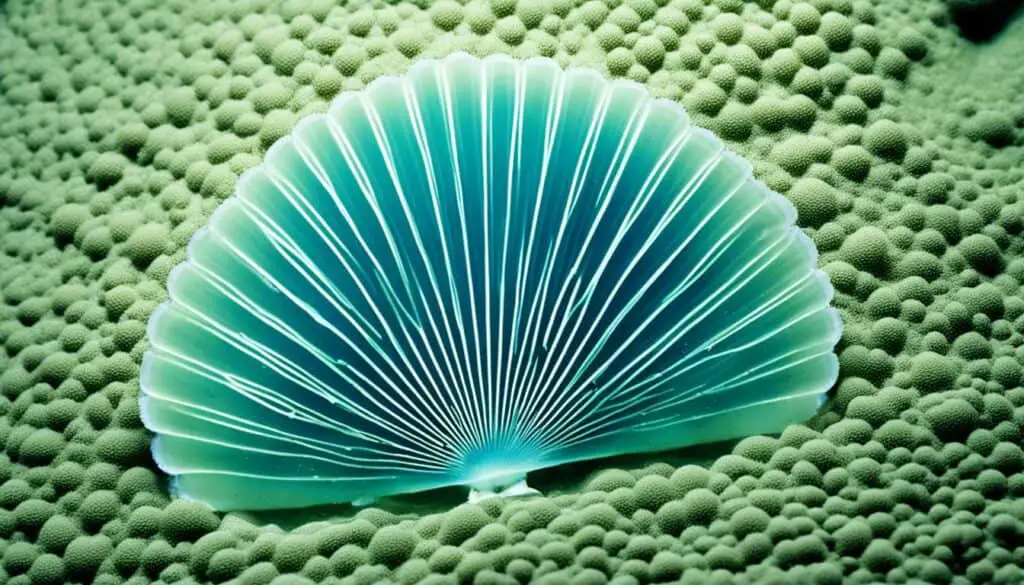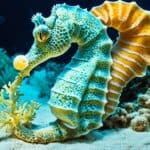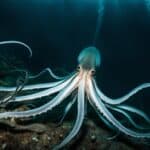Scallops are not just tasty on your plate but also have a unique way of eating. They use a special method called filter feeding. This process helps them survive in the ocean by catching tiny organisms in the water.
Scallops have a special body shape that lets them filter out small food particles from the water. They open their shells to let water flow in. This way, they can eat plankton and other small bits that are important for their diet.
This feeding method is key to their survival and helps the ocean stay healthy. By eating plankton and detritus, scallops help keep the ecosystem balanced. So, scallops are more than just a food item; they are an important part of the ocean’s health.
Understanding Scallop Anatomy and Physiology
To understand scallops, we must look at their anatomy and physiology. Their body structure is key to their survival and how they eat. This part will cover the details of their body and how it helps them eat.
Body Structure of Scallops
Scallops have a unique two-part shell, known as valves. These shells protect their organs and are vital to their life. The left valve is deeper and more rounded, helping them hide from predators on the ocean floor.
Scallops also have about 100 small eyes along their mantle edge. These eyes help them spot threats and find food.
Role of Valves in Feeding
The valves of scallops are crucial for filter feeding. When open, they let water in, trapping food particles. This way, scallops can eat efficiently and stay safe from predators when their valves close.
Learning about scallop anatomy shows how these creatures survive and thrive in the ocean.
How do scallops filter feed?
Scallops have a unique way of feeding that is both efficient and adaptable. They use a special system to catch food particles in the water. This process is key to their survival in the ocean.
The Mechanism of Filter Feeding
Water flows into the scallop’s shell through its openings. Inside, the gills have a sticky mucus that traps food particles. Then, tiny cilia move these particles towards the mouth for digestion.
The Types of Food Scallops Consume
Scallops eat small particles that float in the water. Their diet includes:
- Phytoplankton
- Detrital matter
- Bacterial cells
- Microalgae
The food scallops eat changes with the environment. This helps them stay important in the ocean’s food web.
| Food Type | Characteristics | Availability |
|---|---|---|
| Phytoplankton | Microscopic plants in the water | High in nutrient-rich waters |
| Detrital Matter | Organic debris from dead organisms | Varies with seasonal changes |
| Bacterial Cells | Microscopic life forms facilitating nutrient cycling | Constantly available in most aquatic environments |
| Microalgae | Small algae that thrive in sunlight | Common in well-lit waters |
Scallop Feeding Behavior
Scallops play a big role in the ocean’s ecosystem. They have unique ways of eating that affect their survival and growth. Their eating habits depend a lot on their environment.
Optimal Feeding Conditions
Scallops do best when there’s plenty of food around, like tiny plants called phytoplankton. These areas let them filter feed well. Knowing where these food sources are important for farming scallops.
The Role of Water Movement in Feeding
Water movement is key for scallops to eat. Currents bring food to them, making sure they always have enough to eat. Scallops use the water to their advantage, getting lots of food with little effort. Understanding this helps us manage their habitats better.

Scallop Filtration Process Explained
Learning how scallops filter water is key to understanding their role in their ecosystem. They start by opening their shell valves, letting water in. This brings in food particles floating in the water. Inside, they have a special system to catch and process these nutrients.
Water Inflow and Particle Trapping
When scallops open their valves, water and food particles like phytoplankton come in. Their gills are covered with mucus that catches these particles. This way, scallops get the nutrients they need to survive.
The Role of Cilia in Food Transport
After catching food, cilia move it towards the mouth. These tiny hairs on the gills work together to push the food into the digestive system. This shows how scallops feed and their role in keeping the water clean and supporting marine life.










